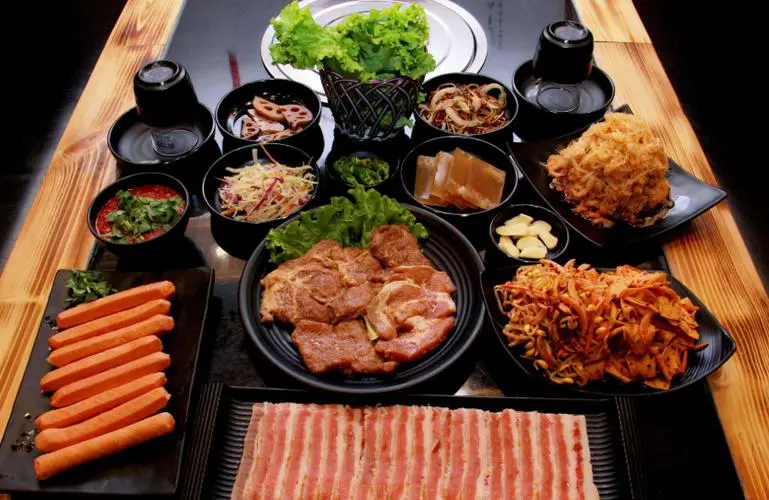Korean BBQ is a unique and interactive culinary experience that sets it apart from other BBQ styles. Here are some key differences between Korean BBQ and other BBQ styles:
- Cooking method: Korean BBQ typically involves grilling thinly sliced marinated or non-marinated meats, seafood, and vegetables at the table using a built-in gas or charcoal grill. In contrast, other BBQ styles like American BBQ often involve smoking or slow-cooking larger cuts of meat at a low temperature for an extended period.
- Meat selection: Korean BBQ features a variety of meats, including beef, pork, and chicken. Popular cuts include bulgogi (thinly sliced marinated beef), galbi (marinated short ribs), and samgyeopsal (pork belly). Other BBQ styles often focus on specific types of meat, such as pork ribs or beef brisket in American BBQ.
- Marinades and sauces: Korean BBQ marinades often contain soy sauce, sugar, garlic, sesame oil, and fruit juices (like pear or apple), which create a sweet and savory flavor profile. In addition to marinades, a variety of dipping sauces, such as ssamjang (a spicy and savory soybean paste) and sesame oil with salt and pepper, are also used. Other BBQ styles typically have their own distinct sauces, like tomato-based or vinegar-based sauces in American BBQ.
- Side dishes (banchan): One of the key features of Korean BBQ is the assortment of side dishes, known as banchan, served alongside the grilled meats. Banchan may include kimchi (fermented cabbage), pickled vegetables, various salads, and savory pancakes. In contrast, other BBQ styles usually have their own traditional side dishes, such as coleslaw, baked beans, or cornbread in American BBQ.
- Wrapping and eating: In Korean BBQ, it is common to wrap the grilled meat in lettuce or perilla leaves, along with other ingredients like rice, garlic, and sauces, creating a small parcel called ssam. This practice is less common in other BBQ styles, which often focus on eating the meat with side dishes or in sandwiches.
- Atmosphere and social aspect: Korean BBQ is known for its communal and interactive dining experience, with friends and family gathering around the table to cook and share food together. While other BBQ styles can also be social events, the hands-on aspect of grilling at the table is unique to Korean BBQ.

These differences in cooking methods, meat selection, marinades and sauces, side dishes, and eating practices contribute to the distinctiveness of Korean BBQ compared to other BBQ styles, making it a popular and enjoyable dining experience.
- Soup or stew: Another feature of Korean BBQ that sets it apart from other BBQ styles is the inclusion of soups or stews alongside the grilled meats. Popular options are doenjang jjigae (soybean paste stew), kimchi jjigae (kimchi stew), and sundubu jjigae (soft tofu stew). These soups or stews are often served in a hot, bubbling stone pot, providing a contrasting texture and flavor to the meal. In other BBQ styles, soups and stews are not as commonly served as part of the meal.
- Rice: While some other BBQ styles may include rice as a side dish, steamed white rice is an essential component of a Korean BBQ meal, providing a neutral base to complement the bold flavors of the grilled meats and side dishes. Rice also plays an important role in Korean cuisine as a whole, highlighting the interconnectedness of various dishes and flavors.
- Table setting and utensils: In Korean BBQ, the table setting often includes metal chopsticks and a spoon for each diner. This is different from other BBQ styles, where forks, knives, and other utensils may be more commonly used. The table is usually arranged with multiple dishes, including the grill, rice, banchan, and other accompaniments, creating a vibrant and colorful display.
- Beverage pairings: Korean BBQ is often enjoyed with traditional Korean beverages like soju (a clear distilled liquor), makgeolli (a milky rice wine), or Korean beer. These beverages are consumed throughout the meal, adding to the social atmosphere of the dining experience. Other BBQ styles may have their own preferred beverage pairings, such as beer or wine, depending on the regional or cultural context.
These additional differences further highlight the unique aspects of Korean BBQ compared to other BBQ styles, emphasizing the cultural and culinary distinctions that make it a beloved and memorable dining experience.